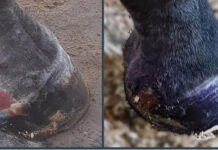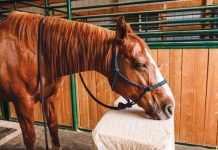Arthritis in horses is a concern of horse owners. The health of a horse’s joints is pivotal for not only his athletic career but also for his quality of life. For these reasons, osteoarthritis—also referred to as degenerative joint disease —is a concern for most horse owners at some point in their horses’ lives.

Causes of Arthritis in Horses
Arthritis in its strictest definition is the inflammation of a joint. This happens when there is deterioration of the articular cartilage within the joint. Lameness results because the cushioning ability of the joint is reduced, or in severe cases, completely gone. When the articular cartilage is worn, bone can grind against bone in the joint, resulting in pain. Inflammatory cells within and around the joint release chemicals that cause pain, too.
Multiple factors contribute to the development of arthritis. These include horse management, genetics and environment. An acute injury to a joint such as a kick or fall can sometimes damage the cartilage enough to induce arthritis.
Most commonly, arthritis develops over time after years of repetitive use, similar to arthritis in humans. As concussive forces continually act on a joint, particularly high-motion joints such as the hock, fetlock and knee, the articular cartilage wears down. This development of arthritis is usually slow and can often be managed fairly well.
Even a horse’s natural conformation can lead to the development of arthritis. Severe conformation faults that result in the misalignment of the joints in the leg can create uneven forces when bearing weight, causing excessive strain on a particular joint. Depending on the severity of the conformational fault, arthritis could occur fairly early in life.
Arthritis Symptoms
Clinical signs of arthritis include mild to moderate lameness that improves as the horse continues to move. This is called “warming out” of the lameness and is typical of arthritis.
Some affected horses will have decreased range of motion in the affected joint, and it may be swollen and painful to the touch.

Diagnosis
Arthritis is diagnosed via a few different methods. Physical examination, a lameness exam, and radiographs (X-rays) are all ways in which a veterinarian will diagnose arthritis in a horse.
Radiographically, an arthritic joint will often have rough edges where they are supposed to be smooth. Sometimes bony proliferation can be seen in more chronic cases, while other times an arthritic joint will appear normal on a radiograph.
Treating Arthritis
It’s important to understand that there is no cure for arthritis, only ways to manage it and slow its course. As they age, most horses will develop arthritis in various joints to some degree.
Mild to moderate age- or use-related arthritis is manageable, and the horse can still retain some degree of athletic performance. Arthritis brought on by trauma is often more severe in a shorter amount of time and can be career-ending.
For most horses with mild to moderate arthritis, there are three common methods of arthritis management: an exercise program, non-steroidal anti-inflammatory drugs (NSAIDs) to relieve pain, and joint supplements to help support the cartilage and joint fluid.
Although years of hard exercise may predispose a horse to developing arthritis, continuation of mild exercise is beneficial to a horse with this condition. The reason behind this is that during inactivity, a horse’s joints become stiff. As a horse moves, this encourages flow of synovial fluid through the joints, lubricating them and easing pain. This is why many horses with mild arthritis can still be ridden, although often at a lower level than in their previous career. For older horses that are retired, or those with more severe arthritis, frequent and regular hand-walking can be beneficial, particularly in the colder months.
Pain Relief:
Phenylbutazone (bute) is the most commonly prescribed NSAID for arthritis management in horses. Some horses can be given bute only as needed, such as after a long ride or on a cold morning. Other horses may require a more regular dosing regimen. Always talk to your veterinarian before starting your horse on any NSAIDs.
A topical NSAID called Surpass is now available for application directly on the affected joint. This more localized application helps prevent some of the classic side effects of systemic NSAIDs, such as gastric ulcers.
Equioxx is another oral NSAID on the market that aids in pain management associated with arthritis. It is different from bute in that it doesn’t inhibit the enzymes that produce protective stomach mucus, making it a safer choice for horses prone to gastric ulcers.
Oral Supplements
Oral joint supplements are readily available and can be given with your horse’s feed. The most commonly used ingredients in these are chondroitin and glucosamine. By providing extra amounts of the building blocks of joint cartilage via daily supplements, the theory is that these ingredients for cartilage health and joint lubrication are absorbed into the bloodstream and make it to the joints to repair damage that has already been done and prevent further damage from occurring. Some of the ingredients in joint supplements also have anti-inflammatory properties.
Other ingredients you might see in joint supplements include omega-3 fatty acids, avocado and soybean unsaponifiables (ASU), methylsulfonylmethane (MSM), and herbal ingredients such as devil’s claw and garlic. When contemplating starting your horse on a joint supplement, always consult your veterinarian.

Injectable Treatments:
FDA-approved injectable arthritis treatments are administered by your veterinarian. These include Adequan, which is administered IM (into the muscle), or Legend, given IV (in the jugular vein).
Joint injections are another way some horse owners manage arthritis. A veterinarian will inject an affected joint with a combination of hyaluronic acid and steroid. The hyaluronic acid will act as a synthetic joint fluid to help lubricate the damaged joint and the steroid will act as a strong anti-inflammatory agent. Joint injections are only temporary measures for long-term arthritis management and need to be repeated on a regular basis as needed.
New Horizons in Arthritis Treatment >>
Preventing Arthritis in Horses
There are several things you can do to help prevent or at least slow down the development of arthritis in your horse. An appropriate exercise program is one of the most important things to consider. Making sure your horse is conditioned enough for the performance you ask is imperative, as frequent, sudden, intense exercise in an under-conditioned horse can cause excessive wear and tear on his joints. Good footing is also important. Whenever possible, avoid rough, hard ground such as pavement, and opt for arenas with soft footing and fields with grass.
Shoeing is another key management issue. Keeping your horse’s hooves regularly trimmed helps ensure proper weight distribution and bony alignment as your horse moves and stands. If your horse has particular conformation issues, such as a long toe and under-run heel, specialized trimming and even certain shoes may further help protect his joints by helping to keep his movement correct. This avoids uneven weight distribution, which can cause excessive stress on joints.
Dietary supplements can also help protect your horse’s joints. Some horse owners, particularly those who know their horses will regularly engage in demanding work such as competitive jumping, dressage, speed events or reining, will give their horses daily joint supplements as part of their diet.
The understanding of equine arthritis is still ongoing. Researchers are learning new aspects about the disease process, and there is continual work toward developing new and improved therapies for this common condition in our horses.
This article originally appeared in the December 2014 issue of Horse Illustrated magazine. Click here to subscribe!





